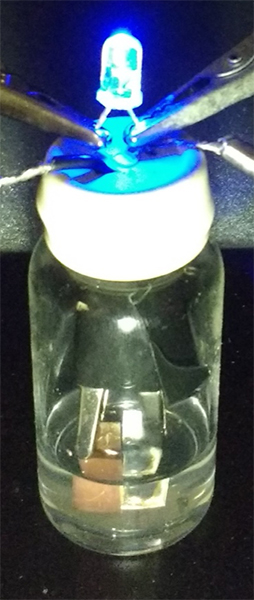Researchers have created a high-performance battery of metal waste and soap.

Take the old metal waste, put it in a glass jar with soapy water and get a high-performance battery. This philosophy is followed by researchers from Vanderbilt University - the creators of a fairly powerful functioning battery from waste copper and steel.
“Imagine that tons of metal waste, which is increasing every year, could be used to power the renewable energy sources of the future, instead of becoming a burden for the environment and processing plants,” said Carey Pint, associate professor of engineering at the University Vanderbilt.
')
Pint led a research team that used fragments of steel and copper — the two most commonly emitted materials — to create the world's first battery of these metals. Such a battery can accumulate energy no worse than the usual lead-acid batteries . By charging speed new development can be compared with ultra-fast supercapacitors.
The research team, consisting of graduates and students of interdisciplinary programs of Vanderbilt and the Faculty of Mechanical Engineering, described their achievement in the journal ACS Energy Letters. In their work, scientists have demonstrated all the versatility of their technology, which allows you to process steel and copper materials of various shapes, sizes and purity for the production of functional components of the battery.

In the resulting battery, the cell voltage is 1.8 V, the energy density reaches 20 W / h / kg, and the power density up to 20 kW / kg. The battery has sustained 5,000 consecutive charge cycles, equivalent to 13 years of daily charge and discharge. As a result of the experiment, he retained a little over 90% of his power.
The answer to the riddle of such performance lies in the anodization - a widespread procedure for building up the oxide film using anodic oxidation. Most often it is used to impart strength and decorative aluminum finish, but the anodizing procedure can be carried out with almost any metal. This can be done even at home, although not recommended.
At the first stage, preparatory work is carried out: the surface of the metal is polished and ground. Then degreasing is performed, most often with the help of organic solvents such as gasoline, alcohol or acetone, and treatment with alkali (ordinary soap solution). The next stage is decapitation of the surface with a concentrated solution of sulfuric acid and chromic. This is done in order to remove oxides that prevent the application of a new coating. Further, actually, anodizing is the oxidation of a metal in an electrolytic solution under the influence of a direct current. A solution of sulfuric acid, but less concentrated, is also suitable as a current conducting substance. It is unlikely that you will find it at home, so you can replace with a solution of salt and soda.
To convert copper and steel into functional electrodes for rechargeable energy storage, room temperature is sufficient. Under its influence, these multicomponent alloys are converted to iron oxide, active in redox reactions, and copper oxide. When steel and copper wastes were anodized using detergent solution and electric current, the researchers found that metal surfaces were rearranged into nanometer-sized metal oxide networks that could store and release energy when interacting with water-based electrolyte solutions.
The group concluded that these areas with nanometer networks explain such a fast charge process and exceptional battery stability. In the creation of batteries made of copper and steel, non-flammable aqueous solutions of electrolytes were used, which contain potassium hydroxide - an inexpensive alkali, which is used in the production of laundry detergent.

The first battery prototype
Pint notes that when your main goal is to produce materials for scrap batteries so cheaply that large-scale production facilities make no sense, you have to approach this somehow differently than conducting experiments in a research laboratory.
“We see that modern society is gradually moving towards a“ culture of creation, ”where large-scale production of new products gradually scales to individuals or communities. Until now, the batteries have remained outside this culture, but I believe that the day will come when residents will disconnect from the network and will produce their own batteries. This is the level from which battery technology began, and I think we can get back to it, ”says Pint.
A team of scientists from the University of Vanderbilt drew inspiration from the Baghdad battery - a simple device, invented 2000 years before the birth of Alessandro Volta. It consisted of a clay pot, a copper sheet and an iron rod, which were found along with traces of electrolyte. It is assumed that such a battery, filled with alkali or acid, could create a voltage of 1V. Scientists over the past century have experimented with this battery cell, trying to make an exact copy of the Baghdad battery and reproduce the reaction. The experiences included in the story were extremely successful. However, some skeptical scientists believe that the fact that this artifact can generate energy does not mean that it was used for this purpose. And although the interpretation of this artifact is still controversial, its simple design has become an example for creating a new development. In the future, scientists plan to design a full-scale prototype of a battery suitable for use in energy-efficient smart homes.
“With this project we are opening up new horizons, where a positive result is not commercialization, but a clear set of instructions that can be addressed to the general public. This is an absolute rethinking of battery capabilities that will help circumvent the barriers that hinder innovation in storing and conserving energy, ”says Pint.
Source: https://habr.com/ru/post/398941/
All Articles